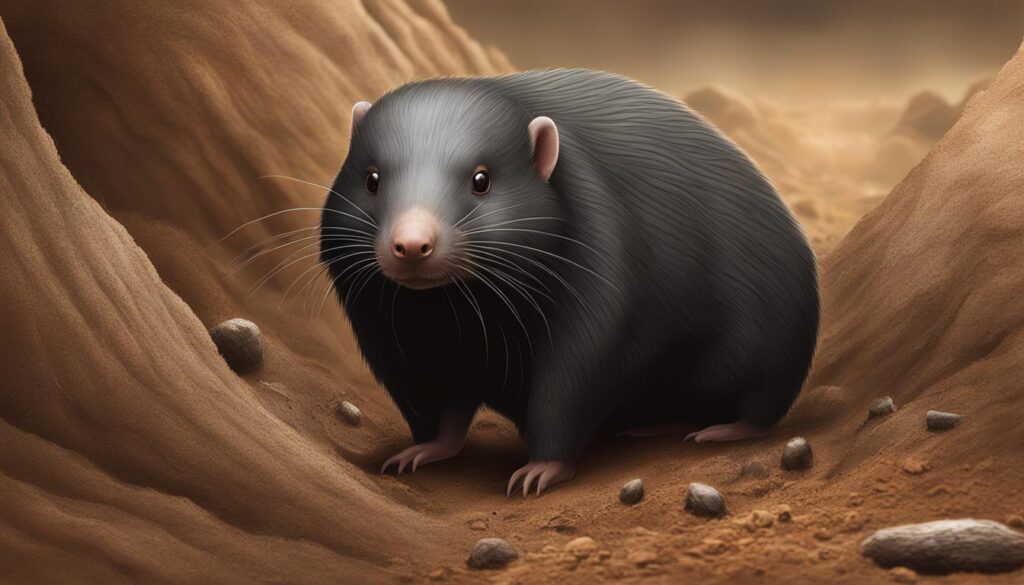Are you noticing mysterious damage to your yard? It could be the work of voles or moles. While these two creatures may sound similar, they have distinct differences that can help you identify and address the problem. In this article, we will explore the dissimilarities between voles and moles and provide tips on how to spot their activity in your yard.
By learning to spot the difference between voles and moles, you can take appropriate control measures to protect your yard. So let’s dive in and discover how to distinguish these backyard critters!
Characteristics of a Mole
Moles are fascinating creatures with distinct characteristics that set them apart from other backyard critters. Understanding their appearance, behavior, and diet can help you better identify and control mole activity in your yard.
When it comes to size, moles typically measure between 4 to 7 inches long. They have unique paddle-shaped feet, equipped with prominent digging claws that allow them to effortlessly tunnel through the ground. Moles have an elongated head and snout, which helps them navigate through the soil as they search for food. They also have small eyes and no external ears.
Their fur is short and varies in color from black to brownish-gray, blending in with their underground environment. This coloring helps them stay concealed while they dig their extensive tunnel systems.
Moles are expert diggers, capable of creating volcano-shaped hills in the lawn with their tunneling activities. It’s not uncommon for them to dig up to 150 feet of new tunnels each day. These tunnels serve as their pathways for hunting and exploring, as well as for protection from predators.
In terms of diet, moles exclusively feed on insects, grubs, and earthworms. They are voracious eaters, consuming up to 60 to 100% of their body weight in prey every day. This diet makes them beneficial for controlling common garden pests, but their tunneling can be a frustrating sight for homeowners.
Now that you have a better understanding of mole characteristics, appearance, diet, and tunneling habits, you can take proactive measures to control their presence in your yard. In the next section, we will explore various effective control methods, including trapping and reducing their food availability.
Controlling Moles in Your Yard
Controlling moles can be a challenge, but there are several methods to consider. Trapping is one of the most effective ways to get rid of moles. Harpoon-style mole traps, such as the mousetrap baited with peanut butter, can be placed over active mole tunnels. It’s important to note that snap traps are ineffective in catching moles. Additionally, reducing or eliminating the food availability for moles can help control their population. This can be achieved by using grub treatments for the lawn or systemic grub treatments containing imidacloprid. Castor oil products are often marketed as mole repellents, but their effectiveness is limited. It’s important to carefully follow label instructions when using any type of poison or chemical for mole control.
Characteristics of a Vole
Voles are small rodents that resemble field mice, with short tails, compact heavy bodies, and small eyes. They have reddish-brown or black fur, providing them with excellent camouflage in their natural habitats. One distinguishing feature of voles is their prominent orange teeth, which are specially adapted for gnawing through plant roots and stems.
As herbivores, voles primarily feed on the roots, bulbs, seeds, and inner bark of trees. Their constant gnawing on plants can cause significant damage to gardens, orchards, and other vegetation. Voles create golf ball-sized exit holes in previously established mole tunnels, using these tunnels as a network for travel and protection.
Another interesting characteristic of voles is their tendency to leave behind distinctive side-by-side grooves on wood. These marks are a result of their continuous gnawing behavior and can be a clear indication of vole activity in an area.
Voles are prolific reproducers, with the ability to produce 5 to 10 litters per year. Each litter typically consists of around 5 babies, allowing the vole population to grow rapidly if left unchecked. To further complicate matters, voles live in colonies, increasing their potential for widespread damage.
To control voles in your yard, habitat modification is essential. By removing weeds, excess mulch, dense vegetation, and litter, you can eliminate their food sources and discourage their presence. Preventing access to their favored plants and trees through physical barriers can also be effective.
Controlling Voles in Your Yard
When it comes to vole control, modifying their habitat is the key. Start by removing weeds, excess mulch, dense vegetation, and any litter from your yard. By doing so, you will eliminate their food sources and significantly reduce vole populations.
To physically catch voles, setting snap traps can be an effective method. Bait the traps with apples or a mixture of peanut butter and oatmeal to attract the voles. Place the traps along their runways or near exit holes, as these are the areas where they are frequently active.
It’s essential to take precautions to protect children, pets, and other animals when using vole traps. Always ensure that the traps are securely set and inaccessible to unintended targets.
There are also vole repellents available on the market that can deter these pests from your yard. Some repellents contain capsaicin, which alters the taste of plants, making them unappetizing to voles. Apply these repellents according to the package instructions to achieve the best results.
It’s crucial to keep in mind that voles have a high reproductive rate, so proactive measures are necessary for effective control. By following these vole control methods, you can get rid of voles and protect your yard from their damaging activities.
How Can I Tell if Voles or Moles are causing Dollar Spot in my Lawn?
If you’re wondering whether voles or moles are causing dollar spot in your lawn, look for the telltale signs of their presence. Dollar spot lawn treatment will help control the disease, but it’s important to address the root cause of the problem by identifying and addressing the rodent infestation.
Conclusion
In conclusion, it is important to differentiate between voles and moles in order to effectively address the problem they pose in your yard. Voles, being vegetarians, primarily target the roots and stems of plants, while moles, being meat-eaters, feast on insects, grubs, and earthworms. Their distinctive behaviors and characteristics make them easily identifiable.
Moles, with their volcano-shaped hills and extensive tunnel systems, leave a visible mark on your yard. On the other hand, voles create golf ball-sized exit holes and crisscrossed runways, indicating their presence. By understanding these differences, you can implement the appropriate control methods to manage the vole and mole populations.
Trapping is an effective method for addressing both voles and moles. By using traps strategically placed along their pathways, you can effectively reduce their numbers. Additionally, controlling their food availability is crucial. Modify the habitat by removing weeds, excess mulch, dense vegetation, and litter, as this can limit their food sources and deter them from infesting your yard.
In conclusion, by understanding the differences between voles and moles and implementing the appropriate control methods, you can protect your yard from the damage caused by these pests. Take action to address the issue promptly to maintain the health and aesthetics of your outdoor space.











